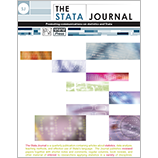Simulating complex survival data
Michael J. Crowther
Department of Health Sciences
University of Leicester
Leicester, UK
[email protected]
|
Paul C. Lambert
Department of Health Sciences
University of Leicester
Leicester, UK
and
Department of Medical Epidemiology and Biostatistics
Karolinska Institutet
Stockholm, Sweden
|
Abstract. Simulation studies are essential for understanding and evaluating both
current and new statistical models. When simulating survival times, one often
assumes an exponential or Weibull distribution for the baseline hazard function,
with survival times generated using the method of Bender, Augustin, and Blettner
(2005, Statistics in Medicine 24: 1713–1723). Assuming a constant or monotonic
hazard can be considered too simplistic and can lack biological plausibility in
many situations. We describe a new user-written command, survsim, which allows
the user to simulate survival times from two-component parametric mixture
models, providing much more flexibility in the underlying hazard. Standard parametric
distributions can also be used, including the exponential, Weibull, and
Gompertz. Furthermore, survival times can be simulated from the all-cause distribution
of cause-specific hazards for competing risks by using the method of
Beyersmann et al. (2009, Statistics in Medicine 24: 956–971). A multinomial distribution
is used to create the event indicator, whereby the probability of experiencing
each event at a simulated time t is the cause-specific hazard divided by
the all-cause hazard evaluated at time t. Baseline covariates can be included in all
scenarios. We also describe the extension to incorporate nonproportional hazards
in standard parametric and competing-risks scenarios.
View all articles by these authors:
Michael J. Crowther, Paul C. Lambert
View all articles with these keywords:
survsim, simulation, survival analysis, mixture models, competing risks
Download citation: BibTeX RIS
Download citation and abstract: BibTeX RIS
|
